|
The material on this website is intended for educational use only and may not be reproduced for commercial purposes without express permission from the appropriate copyright holder.
Le contenu de ce site Web est destiné à des fins pédagogiques seulement et ne peut être reproduit à des fins commerciales à moins d'en avoir obtenu la permission du titulaire du droit d'auteur approprié.

Cheyenne Indians Attacking a Working Party on the Union Pacific Railway, Harper's Weekly, New York, 7 Sept. 1867, LC95522000

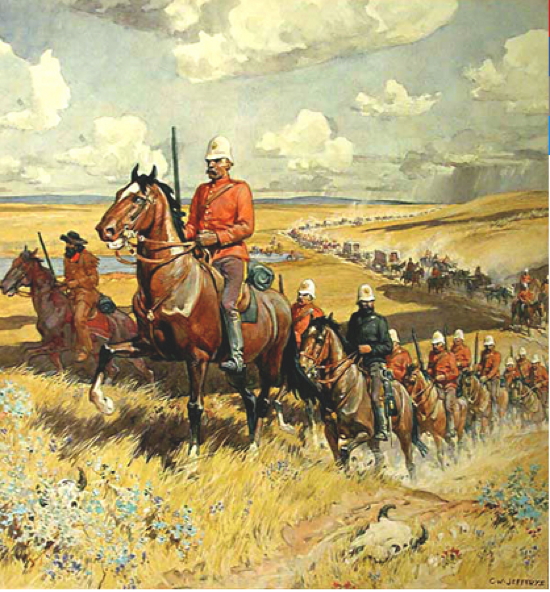
March to the Rockies of the North West Mounted Police, 1950, Charles W. Jefferys

Slaughter of Buffalo on the Kansas Pacific Railroad, William Temple Hornaday, United States National Museum, 12 June 1889, Public domain, via Wikimedia commons
"God, who has always led you [Louis Riel] and assisted you until the present hour, will not abandon you in the dark hours of your life, for He has given you a mission which you must fulfill entirely."
Bishop Ignace Bourget of Montreal, letter to Riel, 14 July 1875
"If the Police had not come to the country, where would we be all now? Bad men and whiskey were killing us so fast that very few indeed of us would have been left today. The Police have protected us as the feathers of the bird protect it from the frosts of winter. . . I am satisfied. I will sign the treaty."
Chief Crowfoot, Blackfoot Crossing, 20 October 1877
"Our mission is to plant the rule
Of Britain's freedom here,
Restrain the lawless savage, and
Protect the pioneer.
And 'tis a proud and daring trust
To hold these vast domains,
With but three hundred men,
The Riders of the Plains."
"The Riders of the Plains," 1878
"The North West Mounted were created not to save the white man from the wild Indians but to save the Indians from the wild white man."
Pierre Berton, 1982
"The Police . . . put an end to the traffic in fire water. I can sleep now safely. Before the arrival of the Police, when I laid my head down at night, every sound frightened me; my sleep was broken; now I can sleep sound and I am not afraid."
Button Chief, Treaty No. 7, 1877

North-West Mounted Police, Fort Calgary. LAC, C-008200, 1878
"Progress – railways, the telegraph, mechanized farming, immigrants from Ontario and later Europe, and an organized government, police and legal system – was inevitable, and neither the Métis nor the Indians could continue to live in their traditional ways."
Richard Gwyn, Nation Maker Sir John A. Macdonald
"At the very same time that the buffalo were reduced to extinction by over-hunting, European Canadians began to move rapidly across the flat and treeless prairies in a way that hadn't been possible in the more challenging terrain of the eastern US and Canada; right after them came railways, liquor supplies, towns and weapons the Indians could never match. Virtually overnight, an entirely new, technology-based socio-economic order enveloped the Indians' way of life, threatening to send it the way of the buffalo. . . It is not easy to identify any people anywhere who have had to cope with so complete and swift an extinction of their way of life. . . this is the great tragedy of Canadian history."
Richard Gwyn, Nation Maker Sir John A. Macdonald
"British Indian policy had two key facets: to protect Aboriginal people from destructive contact with settlers, and to civilize them, or to bring them up to the level of the newcomers in the way they lived and in their religious beliefs. Although idealistic, these two objectives contradicted each other." [the Gradual Civilization Act of 1857 and the Indian Act of 1876].
Richard Gwyn, Nation Maker Sir John A. Macdonald


Slaughtered for the hide, Harper's Weekly, New York, 12 December 1874, LC2004678777

Buffalo bones gathered from the Prairies, Library and Archives Canada / PA-066544
"On arriving there I found about 1300 Indians in a very destitute condition, and many on the verge of starvation. Young men who were known to be stout and hearty fellows some months ago were quite emaciated and so weak they could hardly work ; the old people and widows, who with their children live on the charity of the younger and more prosperous, had nothing, and many a pitiable tale was told of the misery they had endured."
Lt. Gov. Edgar Dewdney, Blackfoot Crossing, July 1879
Edgar Dewdney to John A. Macdonald, Superintendent-General of Indian Affairs, 2 January 1880, quoted in A.J. Looy, “The Indian Agent and his Role in the Administration of the North-West Superintendency, 1876–1893” (Ph.D. thesis, Queen’s University, 1977), 143.

The Cheyennes' death struggle - last desperate resistance of the remnant of the frenzied Red Men to the United States troops under Captain Wessells in a deep ravine, near Fort Robinson, Neb., The National Police Gazette, 8 Feb. 1879 LC2003690107

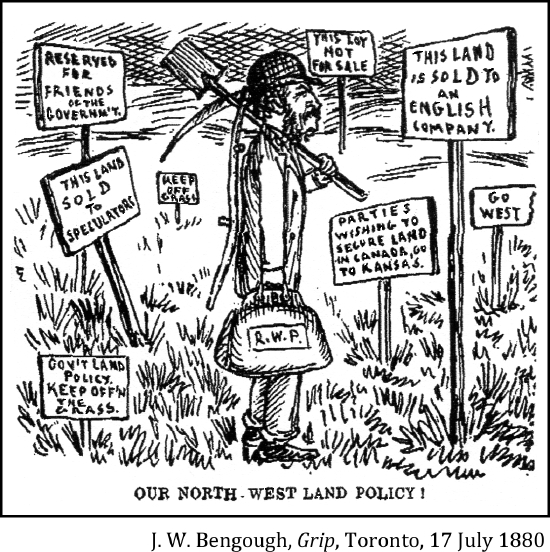

Crowfoot addressing the Marquis of Lorne, Governor General of Canada (son-in-law of Queen Victoria); pow-wow at Blackfoot Crossing, Bow River, September 10, 1881. LAC Acc. No. 1984-45-213, Sydney Prior Hall, 10 September 1881 [Crowfoot holding a cup to show how much flour was doled out to each of his people (inadequate rations), Marquis of Lorne seated on a chair, Edgar Dewdney the bearded figure with a straw hat seated slightly Lorne to his right.]
[Chief Poundmaker accompanied the Marquis of Lorne on his tour of the railway's route to the Rockies.]
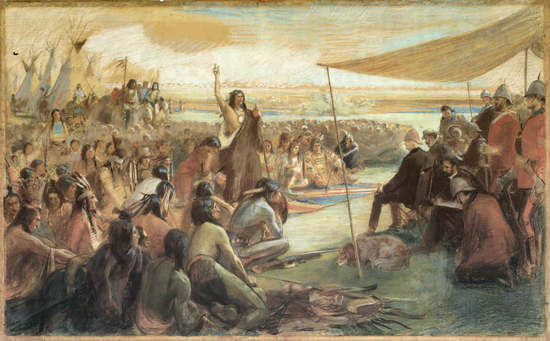
Crowfoot addressing the Marquis of Lorne, Governor General of Canada (son-in-law of Queen Victoria); pow-wow at Blackfoot Crossing, Bow River, September 10, 1881. LAC Acc. No. 1984-45-213, Sydney Prior Hall, 10 September 1881 [Crowfoot holding a cup to show how much flour was doled out to each of his people (inadequate rations), Marquis of Lorne seated on a chair, Edgar Dewdney the bearded figure with a straw hat seated slightly Lorne to his right.]
The Marquis of Lorne was on a tour of the Northwest to assess the area's potential for settlement of prospective British immigrants.

Key, Pow Wow at Blackfoot Crossing. LAC No. 1984-45-271, Sydney Prior Hall, November 1907
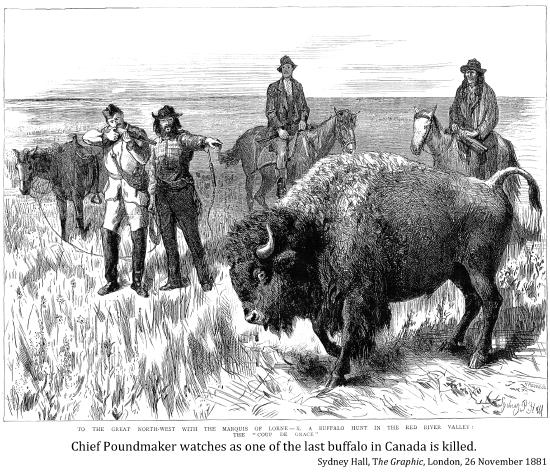
[Chief Poundmaker accompanied the Marquis of Lorne on his tour of the railway's route to the Rockies.]

Harper's Weekly, New York, 2 August 1884


Puck, New York, 11 April 1882

Surveys and Mapping Branch, Ottawa, 1969

[In 1883 Chief Piapot camped his people at the right-of-way of the CPR construction at Maple Creek.]



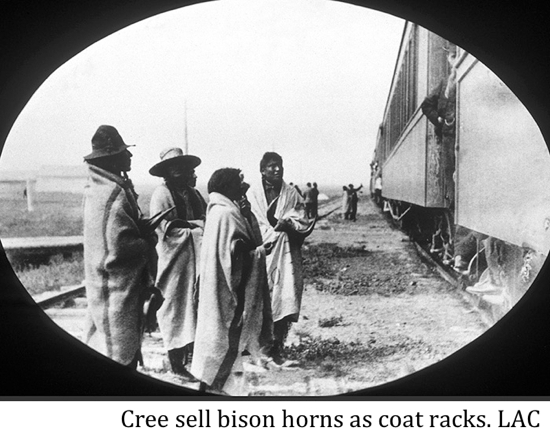
"The short-sightedness and absurdity of the order [Deputy Superintendent of Indians Affairs, Lawrence Vankoughnet's decision to reduce rations and institute other austerity measures in early1884] is . . . evidence of a lamentable ignorance of western Indian reservations and conditions."
Mounted Police officer Cecil Denny (Denny resigned)
"Was it not by armed rebellion, coupled with murder, that Manitoba attained the rights she enjoys today from the very men who now hold the reins of power at Ottawa? If history is to be taken as a guide, what could be plainer than that without rebellion the people of the Northwest need expect nothing, while with rebellion, successful or otherwise, they may reasonably expect to get their rights."
Frank Oliver, Edmonton Bulletin , 22 February 1884
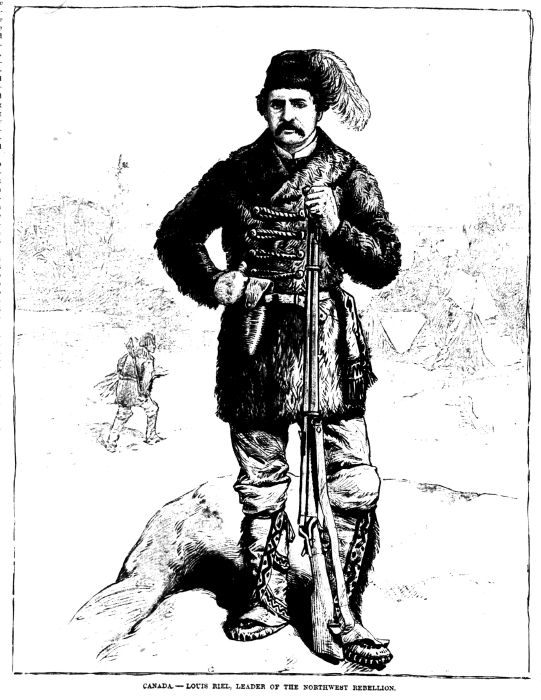
Louis Riel, Frank Leslie's Illustrated Newspaper, New York, April 1884
"The cause of the discontent [in 1885] is no secret to any person living in the North-West. Promises made when the Indians were strong and the whites weak are not carried out now that the whites have become strong and the Indians weak."
Frank Oliver, Edmonton Bulletin, 14 June 1884

"They [the Indians] are our kin and when they starve they come to us for help, and we have to feed them. This Government does not treat them properly."
Gabriel Dumont to Amadée Forget, 6 September 1884

Lt. Gov. Dewdney and his wife at Government House in Regina. LAC PA-118778, Oliver Buell, 1885

Poundmaker and his 4th wife, 1884, LAC PA-066596
"He [Poundmaker] possesses the audacious courage, the noble bearing, the handsome face, athletic figure, and general manliness of the Blackfoot; the industry, shrewdness and skill in the chase of the Assiniboine or Stoney; the caution, cunning and dogged determination of the Cree."
Ernest J. Chambers, 1961

Mistahi maskwa (Big Bear ca. 1825-1888), a Plains Cree chief, trading. LAC, PA-118768, Oliver Buell 1884
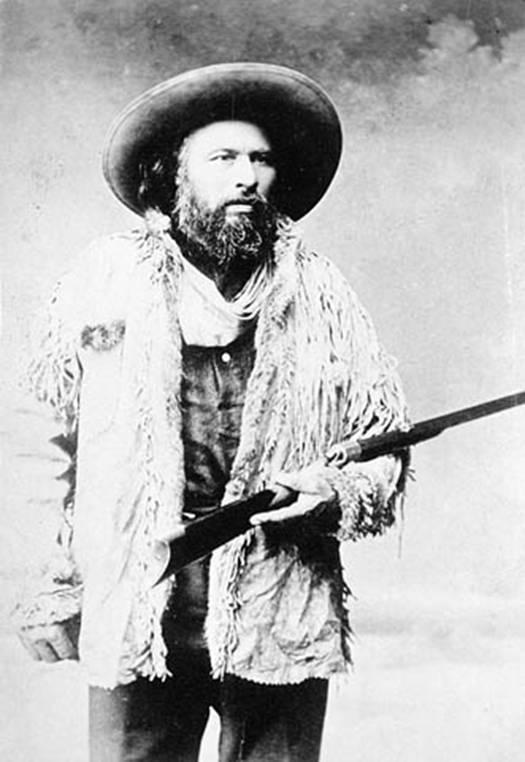
Gabriel Dumont (1837-1906), Military Commander of the Métis during the North West Rebellion of 1885. Strong/Library and Archives Canada/PA-178147


St. Peter’s, Montana.

Petition of Rights
To His Excellency the Governor General of Canada, in Council
We, the undersigned, your humble petitioners, would respectfully submit to Your Excellency in Council, the following as our grievances:
1. that the Indians are so reduced that the settlers in many localities are compelled to furnish them with food, partly to prevent them from dying at their door, partly to preserve the peace of the Territory;
2. that the Half-breeds of the Territory have not received 240 acres of land, each, as did the Manitoba Half- breeds;
3. that the Half-breeds who are in possession of tracts of land have not received patents therefore;
4. that the old settlers of the N.W.T. have not received the same treatment as the old setters of Manitoba;
5. that the claims of settlers on odd numbers, prior to survey, and on reserves, prior to the proclamation of such reserves, are not recognized;
6. that settlers on cancelled claims are limited to eighty acres Homestead and eight acres of pre-emption;
7. that settlers are charged more than one dollar per acre for their preemptions;
8. that settlers are charged dues on timber, rails and firewood required for home use; …
17(h) that the N.W.T. although having a population of 60,000, are not yet granted responsible government, as was Manitoba, when she had less than 12,000 of a population;
17(i) that the N.W.T. and its Premier Province are not yet represented in the Cabinet, as are the Eastern Province,
17(j) that the North West is not allowed the administration of its resources as are the eastern Provinces and British Columbia . . .
Your humble petitioners are of opinion that the shortest and most effectual methods of remedying these grievances would be to grant the N.W.T. responsible government with control of its own resources and just representation in the Federal Parliament and Cabinet.
Wherefore your petitioners humbly pray that your excellency in Council would be pleased to cause the introduction, at the coming session of Parliament, for a measure providing for the complete organization of the District of Saskatchewan as a province, and that they be allowed as in/70, to send Delegates to Ottawa with their Bill of rights; whereby an understanding may be arrived at as to their entry into confederation, with the constitution of a free province . . .
From Louis Riel’s Petition of Rights, Canada, Department of Interior, Dominion Lands Branch, 18 December 1884, File No. 83808.
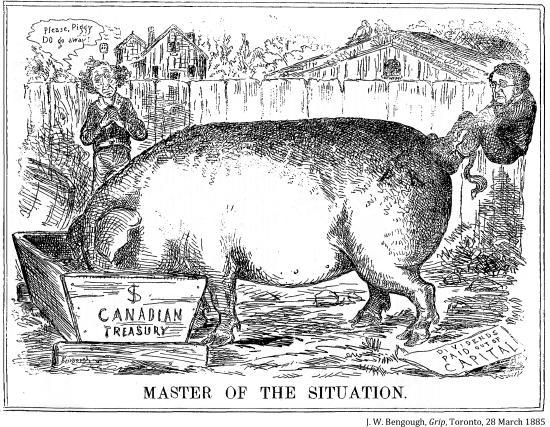
Racial Composition of Saskatchewan, 1881 census (% of population)
Indians, 37,
Mixed-descent 34,
White 23,
Unknown 6
"The time has now come to rule this country or perish in the attempt."
Louis Riel, 18 March 1885



Our Volunteers in the North West, Ottawa, 1885


[Riel actually held up a cross during the battle]
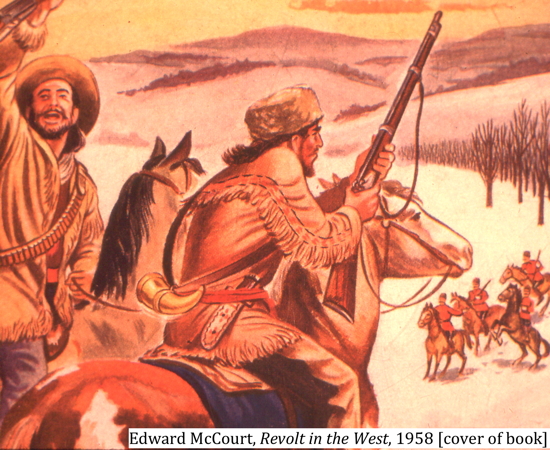

Louis Riel with Cross at Duck Lake, William Perehudoff, Saskatchewan Archives Board, 26944

"I have seen Crowfoot and all the Blackfeet. All quiet. Promised me to be loyal no matter how thing turn out."
Father Lacombe, 30 March 1885
"On behalf of myself and people, I wish to send through you to the Great Mother the words I have given to the Governor [of the North West Territories] at a council held at which all my minor chiefs and young men were present. We are agreed and determined to remain loyal to the Queen… Should any Indian come to our reserve and ask us to join them in war we shall turn them away."
Chief Crowfoot, Blackfoot Crossing, April 1885

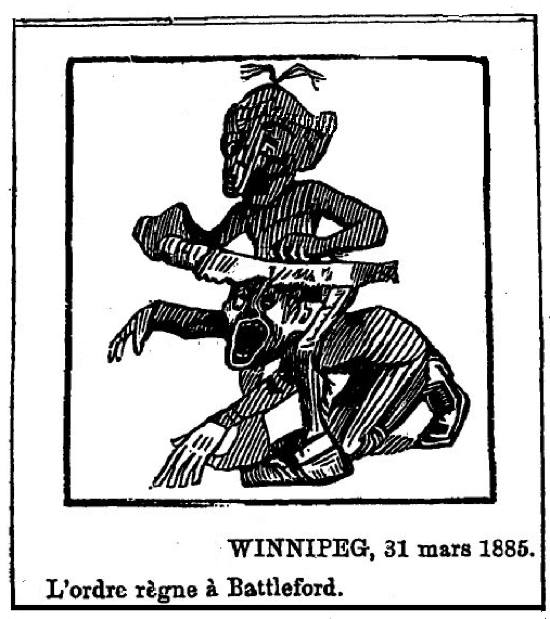
Order reigns in Battleford.
Le canard, Montréal, 4 April 1885


Midnight Tramp of the Royal Grenadiers. William Daniel Blatchly, The Illustrated War News, Toronto, 18 April 1885, LAC C-007684

Camp of the 7th Battalion (Fusiliers) at Winnipeg. LAC Acc. No. 1933-242-48, 15 April 1885

Little Khyber Pass near Battleford. Le passage Little Khyber près de Battleford. [Battleford Relief Column], Robinson Lyndhurst Wadmore, LAC Acc. No. R9266-399 Peter Winkworth Collection of Canadiana, 16 April 1885
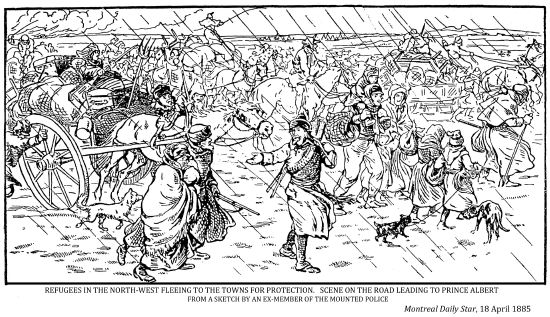

Canadian Illustrated News July 1885
"It is abundantly clear that both half-breeds and Indians have suffered great injustice at the hands of the miscreants in power at Ottawa and their thievish emissaries. The half-breeds have been refused lands and have seen the tide of settlement flowing in around them on every hand, and the land being taken up by corporations and speculators, while they are in danger of being ousted from their homes and driven forth as outcasts from their place of birth. And the Indians have been systematically starved and robbed of their rations and annuities by the party hacks appointed as Indian agents and instructors. It is no wonder, that finding their repeated petitions and complaints discarded, they finally resorted to arms as the only means left them of obtaining redress for their wrongs. . . The poor Indians and half-breeds have not votes, so their appeals for justice have been contemptuously disregarded."
Palladium of Labour, Hamilton, 11 April 1885
"A match will not fire a pile of green wood, but it will a pile of dry. Had the Saskatchewan country been in a satisfied condition a hundred such men as Riel might have come into it and the only harm resulting would have been to themselves . . . The pile was made ready for the firebrand, and the firebrand ready lighted came in the person of Riel."
The Edmonton Bulletin, 1885





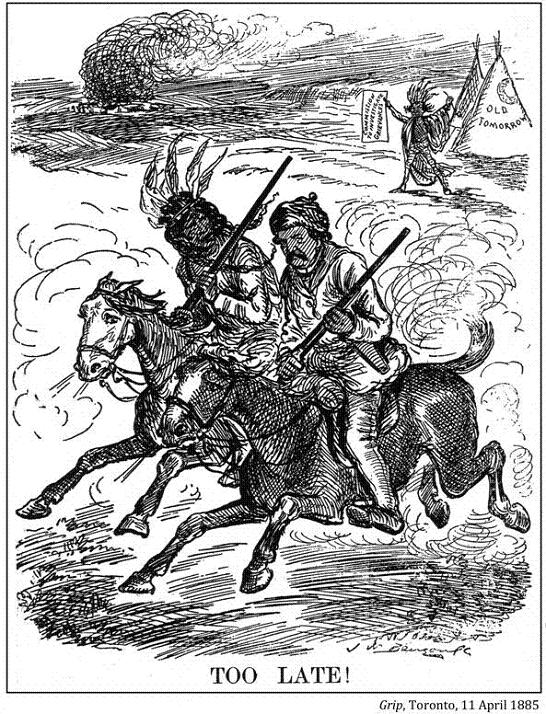

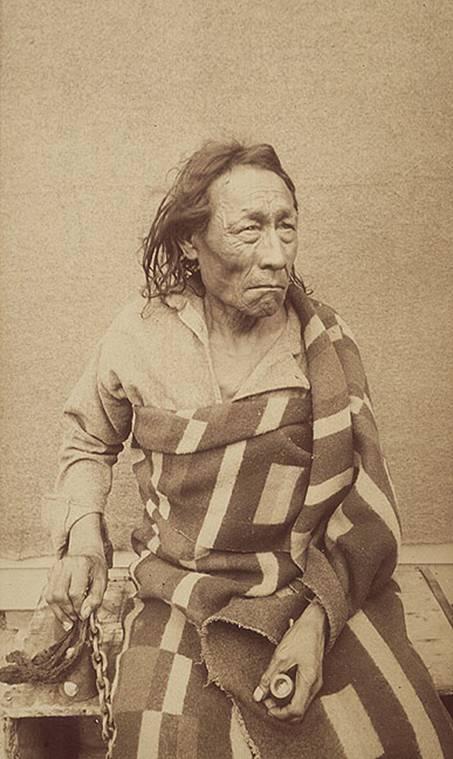
Mistahi maskwa (Big Bear ca. 1825-1888), a Plains Cree chief, Regina, 1885, O.B. Buell / Library and Archives Canada / C-001873
"At last [Frog Lake, 2 April 1885] the Indian department's patronage and penny pinching had blown the bitterness of Indian resentment into a flame that only blood would quench."
James G. MacGregor


"It [Frog Lake] was as if they [the Indians] were trying to lash out against years of deprivation, abuse and wounded pride."
Blair Stonechild

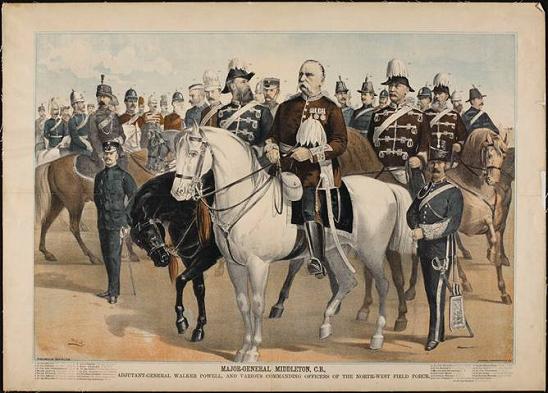
Major-General Middleton, C.B., Adjutant-General Walker Powell, and various commanding officers of the North-West Field Force, By Wm. B., Lithographed by Toronto Lithographing Co., LAC C-005550

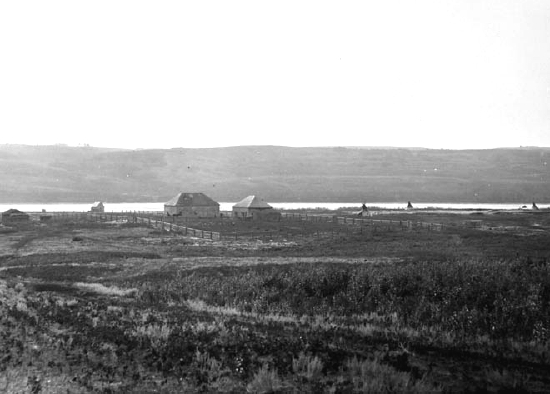
Fort Pitt from the hillside to the northest, Sask. LAC, PA-050808, J. B. Tyrrell, 1886

Fort Pitt 1984
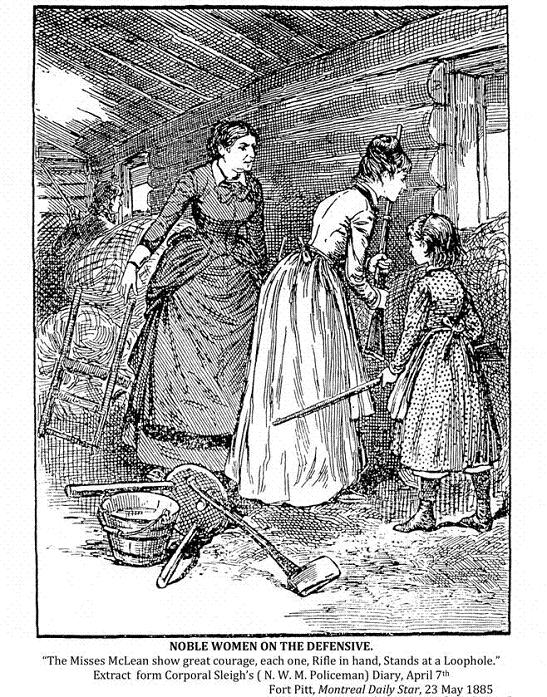

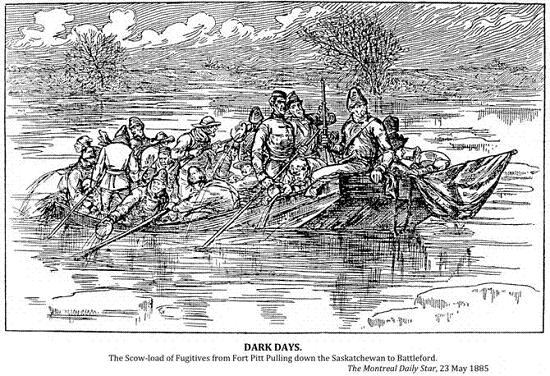
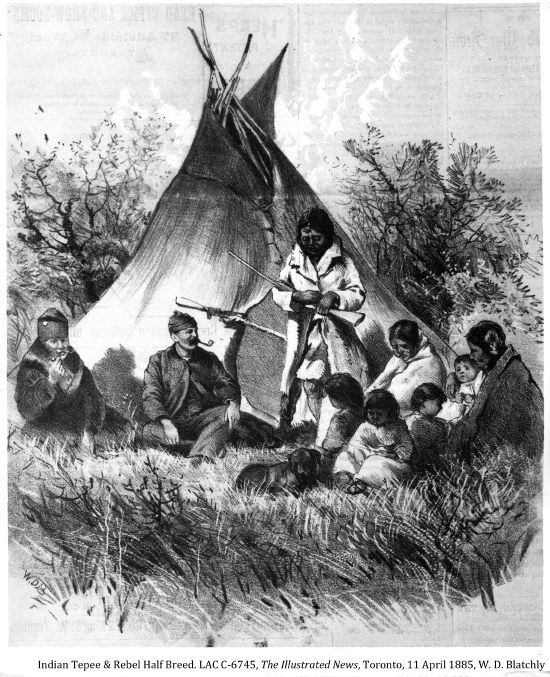
"They [the Metis] never attacked a convoy . . . they never harassed us on the march . . . it would seem as if they intended only to defend their homes against invasion. At Fish Creek they met us on their frontier, at Batoche they fought us on their own doorstep."
Viscount Melgund
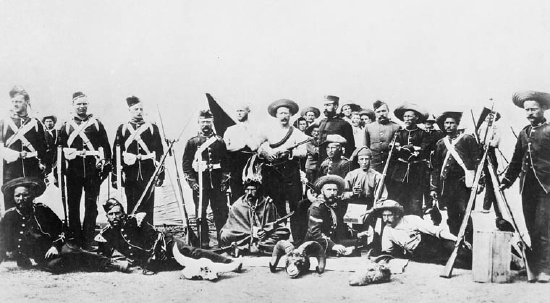
Troops at Medicine Hat, Alta. LAC PA-022434, 1885

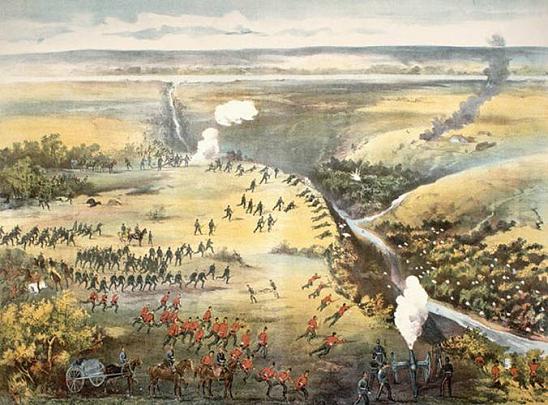
Battle of Fish Creek, Library and Archives Canada, C-002425

Battle of Fish Creek, Imperial Tobacco, Toronto Reference Library ca.1912.Tobacco silk.vs, 1912
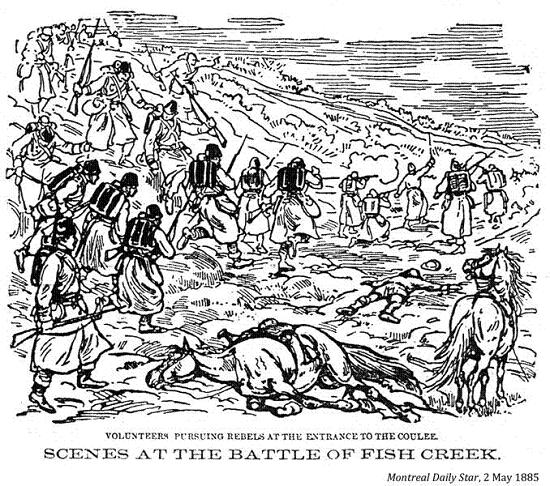

Fish Creek


The Capture of Batoche, Library and Archives Canada, C-002424

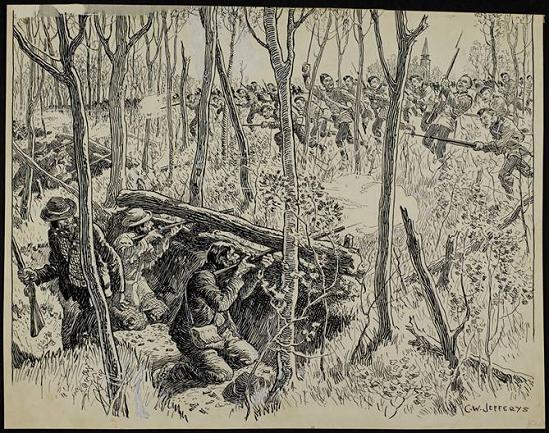
Battle of Batoche, 1885, Library and Archives Canada, Acc. No. 1972-26-774, C-073636

The Canadian Pictorial Illustrated War News, Toronto, 6 June 1885
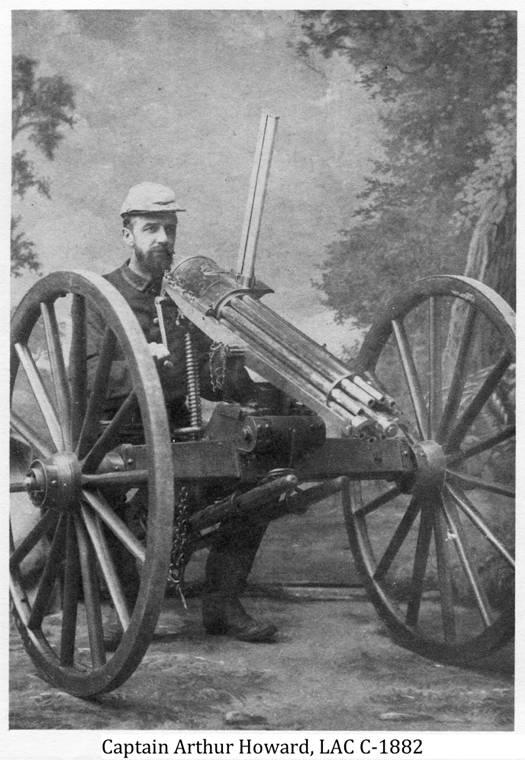
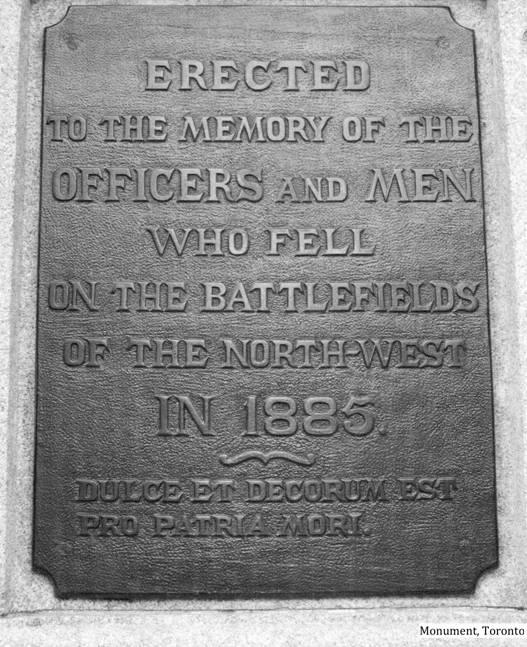
Changes made to the Historic Sites Monument
Interpretive Plaques at Batoche
1924
NORTH WEST REBELLION , BATOCHE, HEADQUARTERS OF THE REBELS
Its capture by General Middleton, after four days fighting, 9th, 10th, 11th, and 12th May, 1885, ended the rebellion. The Midland Regiment, 10th Royal Grenadiers, 90th Regiment, Winnipeg Battery, "A" Battery Boultons Mounted Infantry, and French's Scouts took part in the battle.
1947
BATOCHE
Here, on the 15th of May, after four days of fighting, the Metis under Louis Riel surrendered to General Middleton commanding the Canadian troops.
1985
BATOCHE
In 1879 Xavier Letendre dit Batoche founded a village at this site where Metis freighters crossed the South Saskatchewan River. About 50 families had claimed the river lots in the area by 1884.
Widespread anxiety regarding land claims and a changing economy provoked a resistance against the Canadian Government. Here, 300 Metis and Indians led by Louis Riel and Gabriel Dumont fought a force of 800 men commanded by Major-General Middleton between May 9 and 12, 1885. The resistance failed but the battle did not mean the end of the community of Batoche.
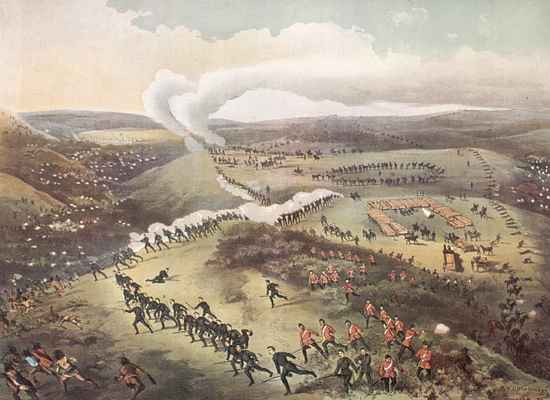
Cut Knife Hill 2 May 1885, LAC C002426k

Action at Cut-Knife Creek. De l'activité à Cut-Knife Creek. LAC, Acc. No. R9266-398 Peter Winkworth Collection of Canadiana, 2 May 1885
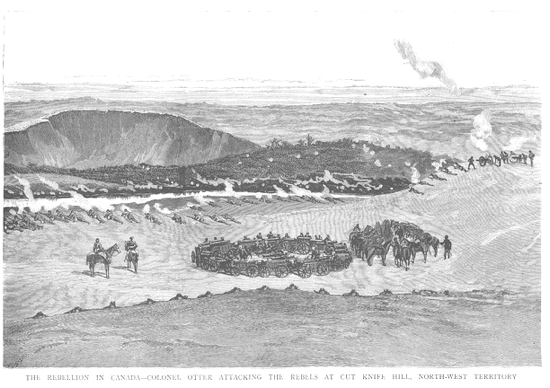
The Rebellion in Canada – Colonel Otter attacking the rebels at Cut Knife Hill. North-West Territory
The Graphic, London, UK, 1885
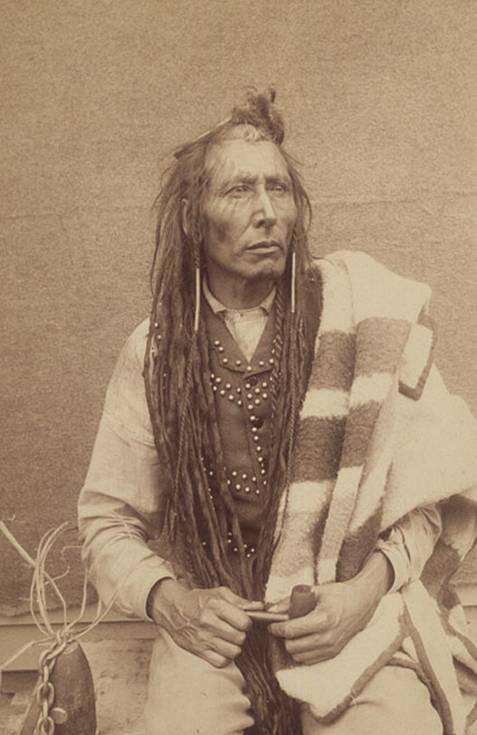
Poundmaker, also known as The Drummer, (ca. 1842-1886), a Cree chief, later adopted by Crowfoot of the Blackfoot Nation, 1885, O.B. Buell/Library and Archives Canada/C-001875

Cut Knife Hill 1 May 1986
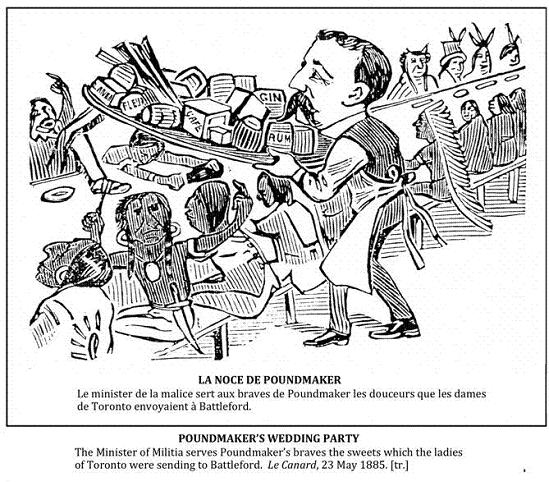
"Lord Wolseley left Toronto on the 21st of May, 1870, and arrived at Fort Garry on the 24th of August, three months. In 1885 the last troops ordered out left Montreal for the front on the 11th of May, and arrived at Winnipeg on the 20th of May, nine days. So much has fifteen years of civilization and a railway done for Canada."
Viscount Melgund

Prisoner Louis Riel in the camp of Major-General Frederick Middleto, James Peters, 1885, LAC C-003450

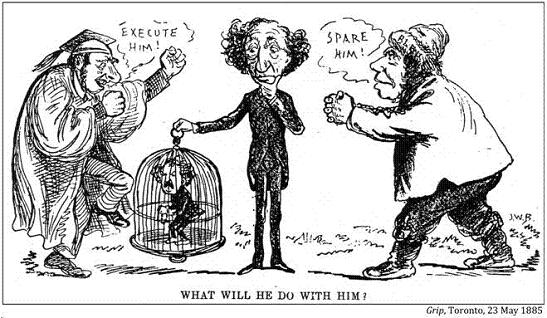
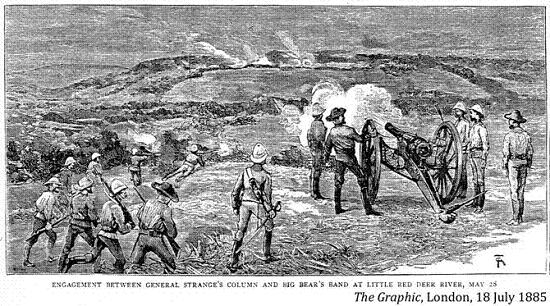
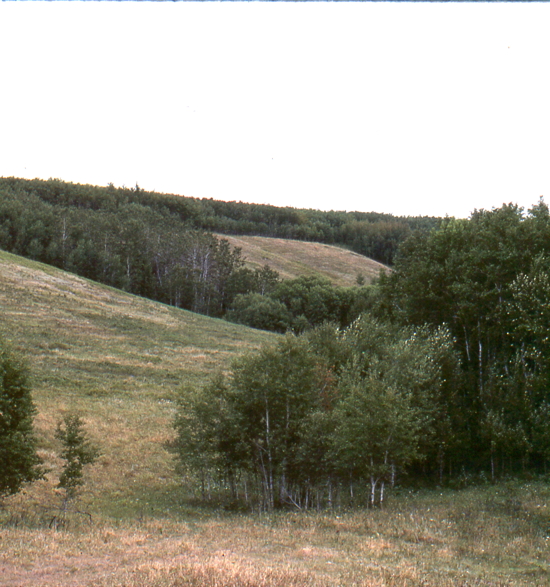
Red Deer Creek 1984
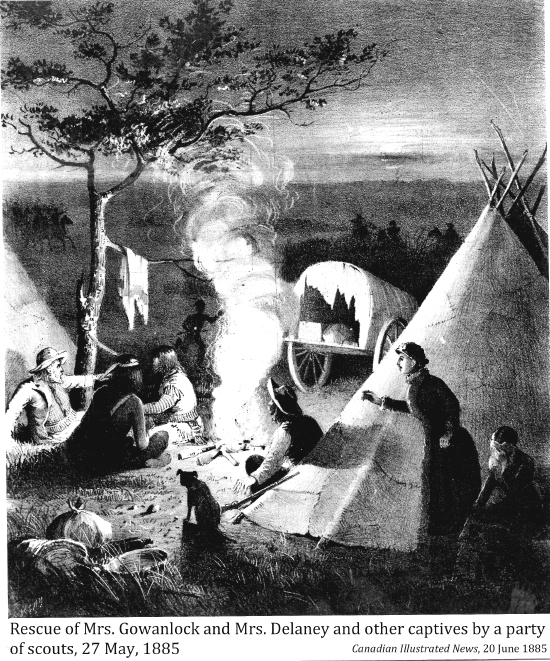



The Surrender of Poundmaker to Major-General Middleton at Battleford, Saskatchewan, on May 26, 1885. Library and Archives Canada, Acc. No. 1991-274-2, C-002769

Key to The Surrender of Poundmaker. Numbered key, drawn in pen and ink, to accompany the painting "The Surrender of Poundmaker to Major General Middleton at Battleford, on May 26th, 1885". Consists of a pen and ink drawing, showing the outlines of the figures in the scene, who are numbered. Drawing is mounted on paper with the handwritten Key to the image, which indicates the names of the 28 persons represented. Library and Archives Canada, Acc. No. 1991-274-1
"Everything I could do was to prevent bloodshed. Had I wanted war, I would not be here but on the prairie. You did not catch me. I gave myself up. You have me because I wanted peace."
Chief Poundmaker, August 1885
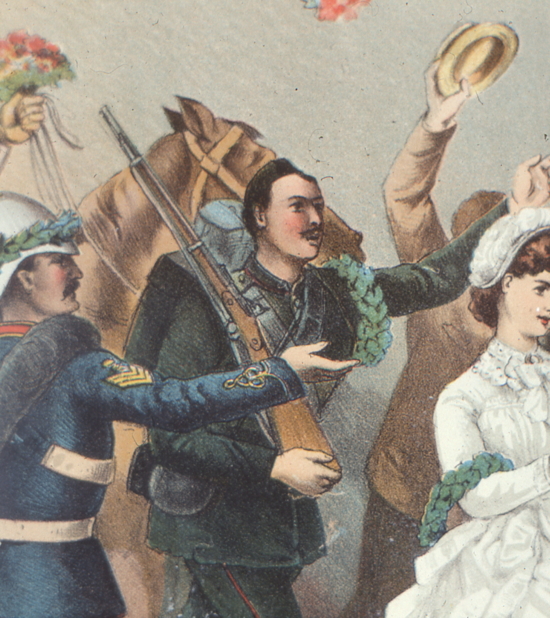
Troops on their return to Toronto 1885
Music played on the return of the Canadian troops in Toronto and in Montreal.
The British Grenadiers
https://www.youtube.com/watch?v=XsW4FoRzhQw
La Marseillase
https://www.youtube.com/watch?v=vKnc9u8y4kw

"These people are not rebels, they are but demanding justice."
Interview in the Toroto Globe, NWMP Major James Walsh

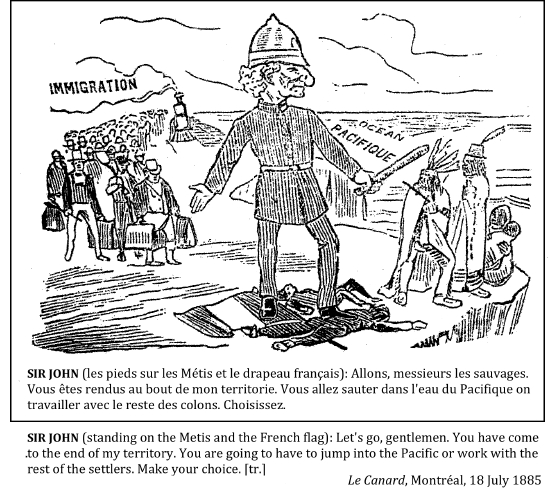

"In this trial of Native by White, it was East against West . . . Ontario against Quebec, Orange against Catholic, Anglo-Saxon against French, Conservative against Liberal. The entire nation was represented and intensely interested."
A. H. Trémaudan

1885, Louis Riel addressing the jury during his trial for treason, O.B. Buell, Library and Archives Canada, 1966-094, C-001879


"If there had been no rebellion, if there had been no resistance, is there anyone of you that can place his hand on his conscience and honestly say that the evils under which this country has complained would have been remedied?"
Charles Fitzpatrick, address to the jury, 1885
"We often remarked that we would like to have the Minister of the Interior in the prisoner's box charged with inciting the Metis by gross neglect and indifference."
Edwin Brooks, jury member, 1925
"Riel was fairly tried, honestly convicted, laudably condemned, and justly executed."
Winnipeg Free Press, 17 December 1885
"If anybody is guilty of 'treason', if anyone deserves death for purely political offences, it is those who have caused this outbreak . . . Sir John Macdonald and his Government. They are the real traitors ¬ – not the handful of desperate, robbed and starving half-breeds and savages who took the only means within their power of protesting effectively against the abuses they had so long complained of in vain."
Palladium of Labour, Hamilton, 11 July 1885
"The trial was a sham, and was indeed not in accordance with present judicial practice . . . it was more a political than a judicial trial."
Bill Yurko
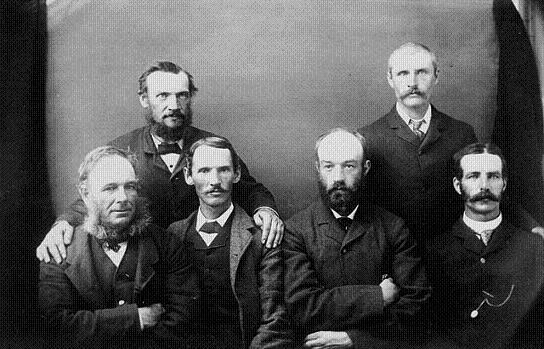
1885, The jury of six at Louis Riel's trial. O.B. Buell / Library and Archives Canada, PA-118759
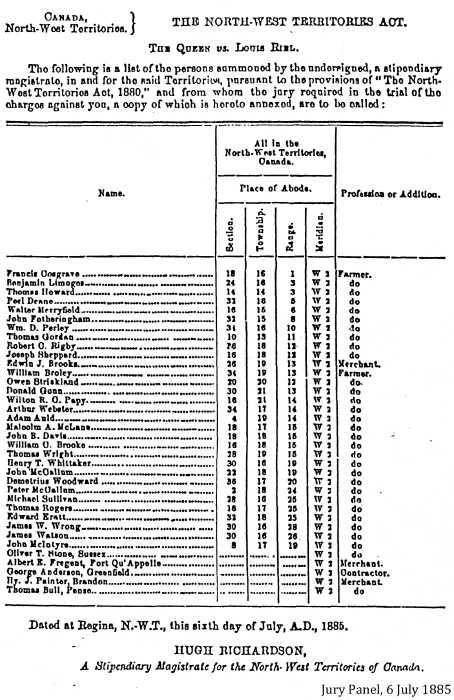
Plot the places of abode of the jury panel on this map


Group photograph of Metis and Native prisoners from the North West Rebellion. Photographie d'un groupe de prisonniers métis et autochtones de la rébellion du Nord-Ouest. (Left to Right): Ignace Poitras, Pierre Parenteau, Baptiste Parenteau, Pierre Gariepy, Ignace Poitras Jr., Albert Monkman, Pierre Vandal, Baptiste Vandal, Joseph Arcand, Maxime Dubois, James Short, Pierre Henry, Baptiste Tourond, Emmanuel Champagne, Kit-a-wa-how (Alex Cagen, ex-chief of the Muskeg Lake Indians). O. B. Buell, LAC PA-118760, August 1885
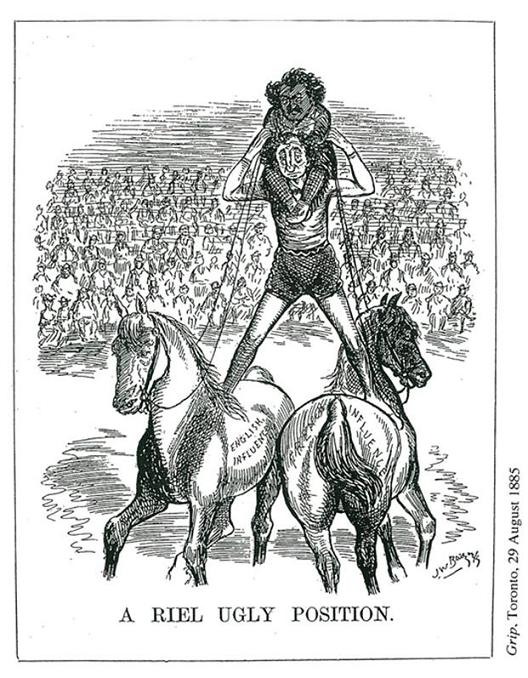



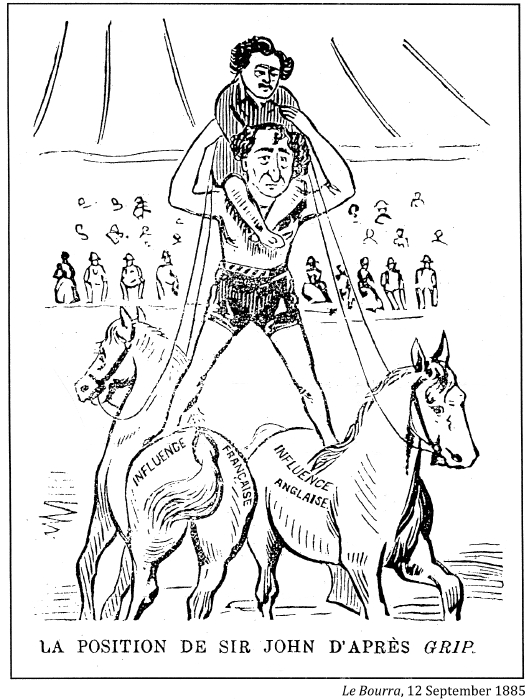
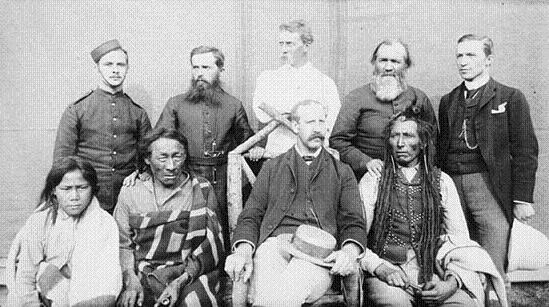
Poundmaker, Big Bear, Big Bear's son, Father Andre, Father Conchin, Chief Stewart, Capt. Deane, Mr. Robertson, and the Court Interpreter, Regina, 1885, Regina, O.B. Buell/Library and Archives Canada/C-001872


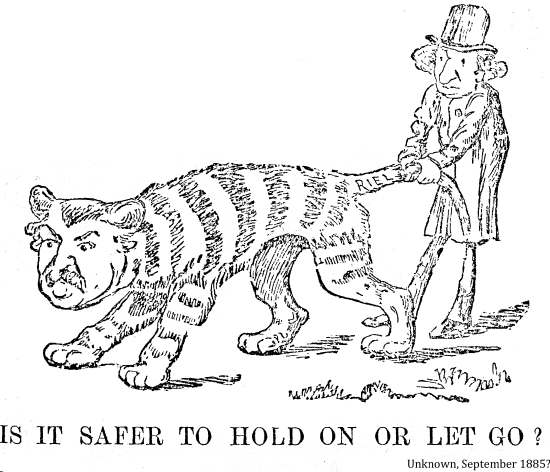
"The enlightened sense of the 19th century was opposed to death sentences for political offences."
George Monro Grant, principal of Queen's University, September 1885


"The execution of political prisoners is, as all true statesmen have taught us, worse than a blunder . . . a leader who embodies the hopes and convictions of thousands becomes almost a sacred person, and the hangman's touch revolts the feelings of his followers as sacrilege does the feelings of the religious."
London, Pall Mall Gazette, 1885
"At the moment when the corpse of Riel falls through the trap and twists in convulsions of agony, at that moment an abyss will be dug that will separate Quebec from English-speaking Canada, especially Ontario."
Israel Tarte, 1885

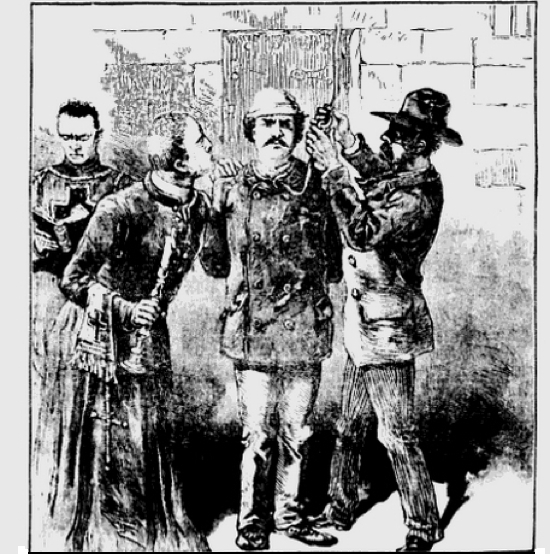
THE EXECUTION OF RIEL
Le Monde Illustré, December 1885
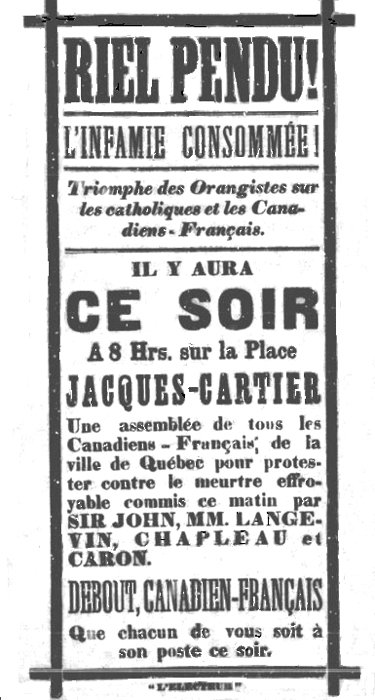
Riel Hanged.
The infamy consummated.
Triumph of the Orangemen over Catholics and French Canadians.
There will be this evening at 8 hrs. at the Place Jacques-Cartier
an assembly of all French Canadians in the city of Québec to protest against the appalling murder committed this morning by Sir John, MM. Langevin, Chapleau and Caron.
Stand tall, French Canadians.
May each of you be at your post tonight.
Flyer, 16 November 1885
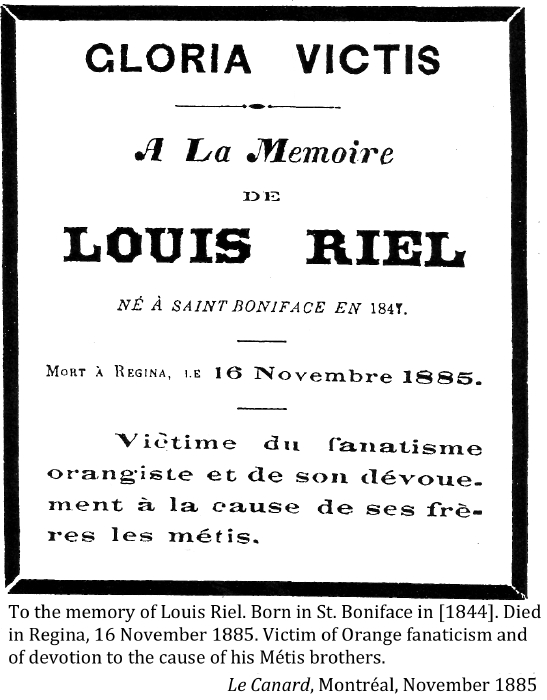
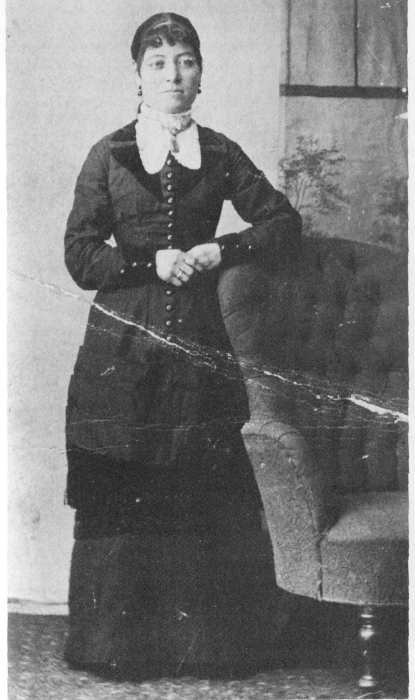
Marguerite Monet Riel, 1885? C-154698


2014
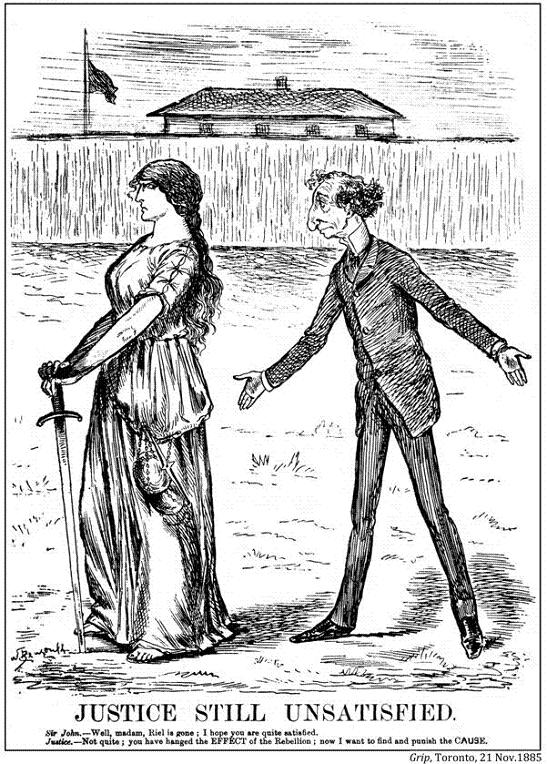
"He shall hang though every dog in Quebec bark in his favour."
Sir John A. Macdonald
[This famous saying did not appear in print until 1909, in a slim biography of Macdonald by George Parkin. Parkin did not cite his source.]
"The execution of Louis Riel was the worst mistake of Macdonald's career."
Richard Gwyn, Nation Maker Sir John A. Macdonald, 2011

"Henceforward there are no more Conservatives nor Liberals . . . there are only PATRIOTS AND TRAITORS."
Headline, La Presse, 22 November 1885
"Had there been no neglect there would have been no rebellion. If no rebellion, then no arrest. If no arrest, no trial. If no trial, no condemnation. If no condemnation, then no execution. They therefore who are responsible for the first are responsible for every link in that fatal chain."
Edward Blake, 1885

Library and Archives Canada, C-018084
Louis Riel, Metis Leader, Executed on November 16, 1885, Political Martyr! Guilty of having loved his oppressed countrymen, Victim of Orange fanaticism to which the politicians sacrificed him without soul and without heart. Let true patriots remember him!! [tr.]
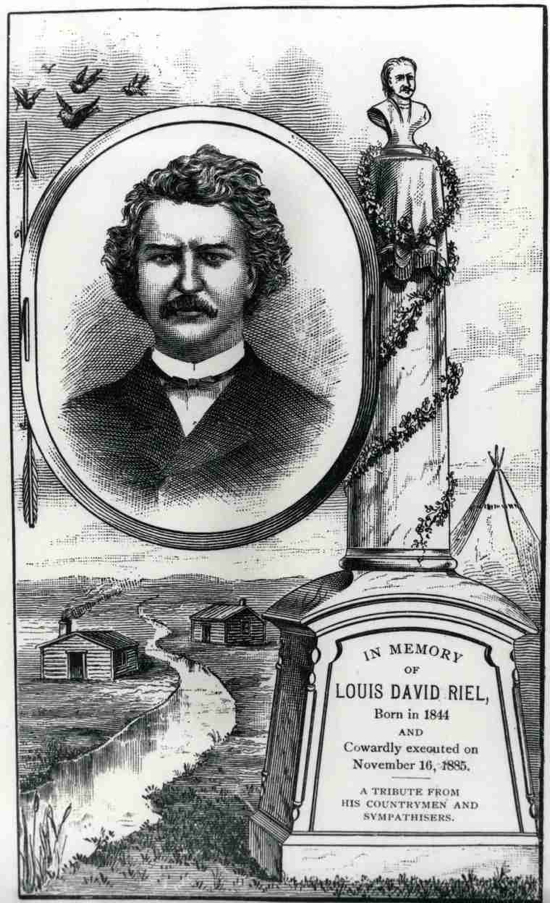
Nov. 16, 1885 "In memory of Louis David Riel":
The Gibbet of Regina, New York, 1886
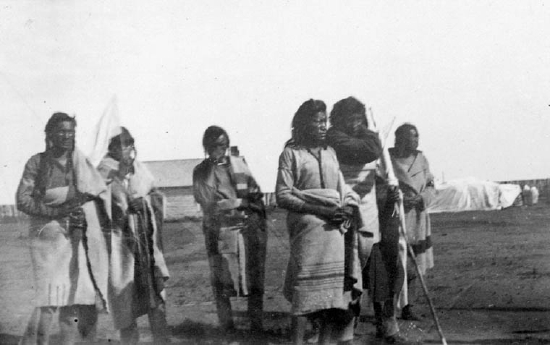
Miserable man surrendering., Six Cree men were tried and sentenced to death for their roles in the Frog Lake Massacre: Miserable Man (Kitahwahken), Bad Arrow (Manchoose), Iron Body (Nahpase), Little Bear (Apischaskoos), Walking the Sky (Pahpahmekeesick), and Wandering Spirit. They, and two Cree men condemned for a murder committed on March 29, 1885 just before the Siege of Battleford were hanged on November 27, 1885, at Fort Battleford, in the largest mass execution in Canadian history. The executions were public, even though such spectacles had long been banned by law. Battleford, LAC, C-004864. James Peters, 1885
"Since the conviction of Big Bear I have felt that it is almost a hopeless task to obtain from a jury in Regina a fair consideration of the case of an Indian."
Beverley Robertson, Winnipeg lawyer, Crown Council to handle defence

Grave of eight indigenous men hung at Battleford on 27 November 1885
[The largest mass hanging in Canadian history occurred when eight warriors were executed in Battleford in November 1885.]

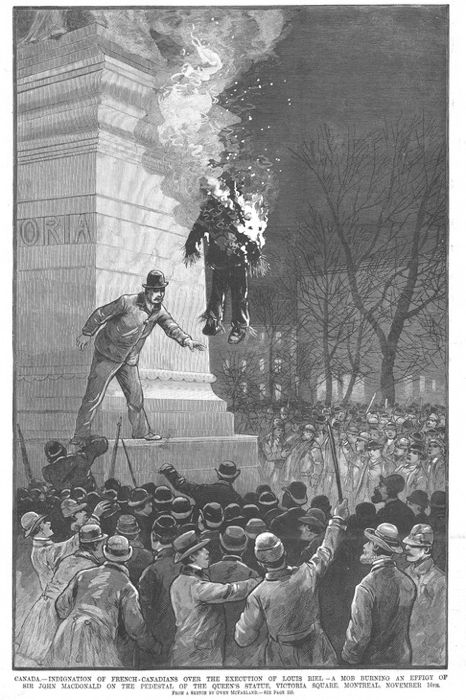
Canada – Indignation of French-Canadians over the execution of Louis Riel – A mob burning an effigy of Sir John A. Macdonald on the pedestal of the Queen's statue, Victoria Square, Montreal, November 16.


Left: Wilfrid Laurier, William James Topley / Library and Archives Canada / C-001967
Right: Toronto World, Metropolitan Toronto Public Library
"Had I been born on the banks of the Saskatchewan, I would myself have shouldered a musket to fight against this neglect of government and the shameless greed of speculators."
Wilfrid Laurier, speech, Montreal, 22 Nov. 1885
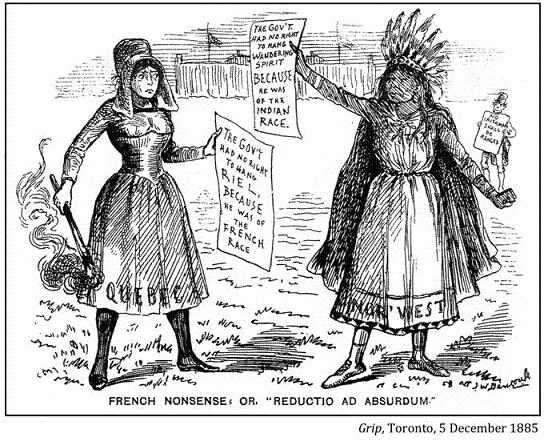
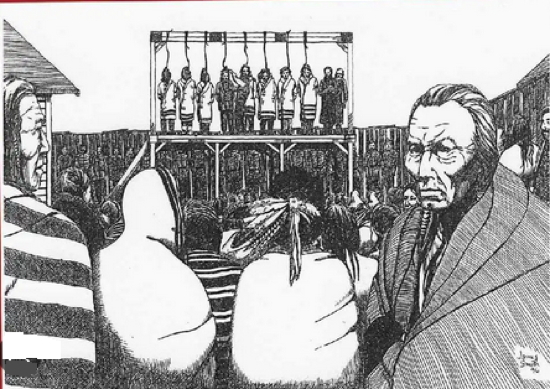
James Smith (artist), Blair Stonechild and Bill Waiser, Loyal till Death and the North-West Rebellion


J. W. Bengough, Grip, Toronto, 12 December 1885
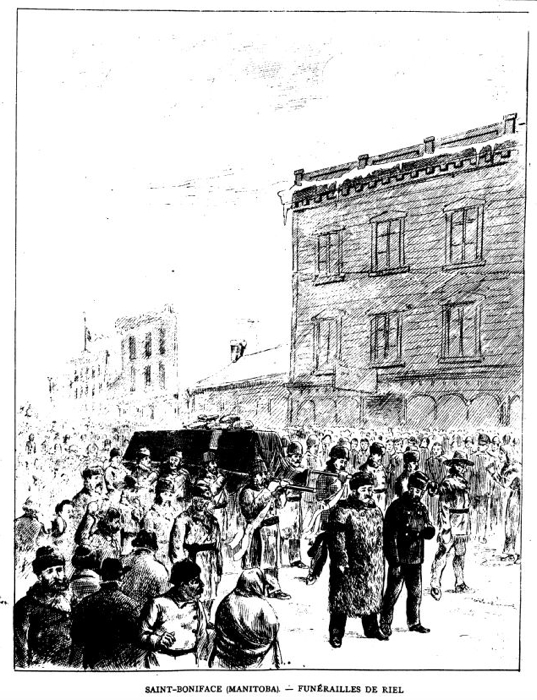
Le monde illustré, Montréal, 26 December 1885

"The march of civilization in the North West then began (1869-70), and today, instead of being a vast hunting ground and wilderness, it is the home of thousands of thrifty settlers, and with its great transcontinental railway from ocean to ocean, placed Canada in the proud position of being one of the brightest jewels of the British Crown."
Alexander Begg, A History of the North-West
"The métis were only doing what men should do; they were merely standing up for their rights."
E. B. Osler, 1961
"[Riel] asserted the rights of westerners to enter the Canadian federation on their own terms, terms that would safeguard their interests; and he asserted them eloquently and persuasively."
George F. G. Stanley, 1965
"The Riel Rebellion was . . . the typical, even inevitable result of the advance of the frontier – the last organized attempts on the part of Canada's primitive peoples to withstand . . . progress, and to preserve their culture and their identity against the encroachments of civilization."
George F. G. Stanley, 1965
"The tragedy of Riel's life and of his death are that they accomplished virtually nothing for the Métis people because they were grounded in violence."
Morris Shumiatcher, 1968
"Louis Riel had at his command no effective means by lawful methods to persuade the government of Canada to respect the rights and wishes of his Métis people. No representative or democratic government existed in the North-West Territories in his time. Herein lies the only possible justification for his outrageous acts of violence."
Morris Shumiatcher, 1968
"Eighty-three years ago in the Mounted Police barracks in Regina, Louis Riel awaited execution as a convicted traitor. This afternoon we are assembled to unveil a monument in his honor. No man in Canadian history suffered as many reversals of fortune during his life. He was, in turn, unofficial leader of his people, president of a provisional government, founder of the province of Manitoba, fugitive in exile, member of Parliament, outlaw, leader of another provisional government, and prisoner. Yet it may be that none of the twists and turns in his tragic biography will be as important to the history of this country as the reversal of official and public opinion which this monument symbolizes."
Pierre Elliot Trudeau, 2 October 1868
"Riel and his followers were protesting against the Government's indifference to their problems and its refusal to consult them in matters of their vital interest. Questions of minority rights have deep roots in our history. It is all too easy, should disturbances erupt, to crush them in the name of law and order. We must never forget that in the long run, a democracy is judged by the way the majority treats the minority. Louis Riel's battle is not yet won."
Pierre Elliot Trudeau, 2 October 1968
Spoken at the unveiling of a statue to Louis Riel
"We know all about Gettysburg and nothing about Batoche, which was the turning point in Canadian history."
Rudy Wiebe, Maclean's, 4 September 1978
"Riel might be a hero and a leader to the Métis, but he has no credentials as a hero to all Canadians, and no school should teach his life that way."
J. L. Granatstein, Who Killed Canadian History, 1998
"Trends towards freedom, democracy, and justice, trends against colonialism, racism and cruelty – they are symbolized by Louis Riel and the movement he led."
John Conway, The Peak, Burnaby, 10 July 1968
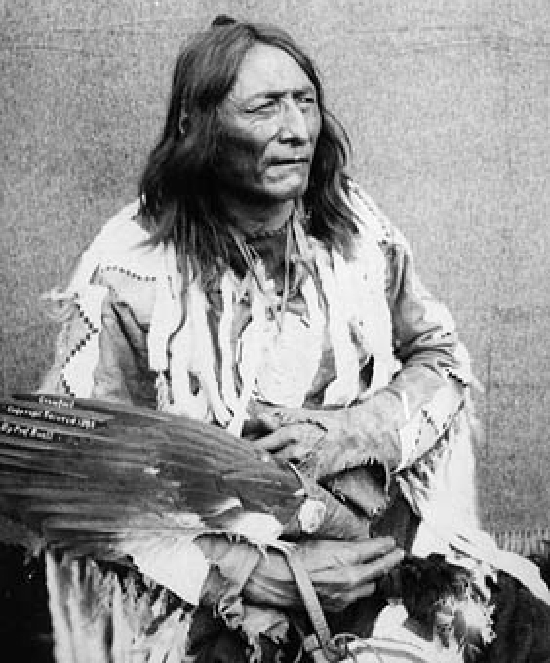
"Crowfoot" or Isapo-Muxika, Chief of the Blackfeet Indians. Pied-de-Corbeau, chef des Pieds-Noirs. Oliver B. Buell, LAC C-001871, 1886
[In July 1886, the Blackfoot leader met Sir John and Lady Macdonald at the Gleichen rail stop in present-day southern Alberta, when the couple crossed the country on the newly completed Canadian Pacific Railway. During the short meeting, Crowfoot expressed an interest in visiting the Premier in Ottawa.]

John A. Macdonald stopped at the Blackfoot Siksika Reserve just east of Calgary on July 22, 1886, during his first trip by rail across Canada. He wanted to thank Chief Crowfoot for his support during the Rebellion of 1885. Crowfoot was wearing his oldest clothes, a sign of mourning for his adopted son Poundmaker, who had died on Crowfoot's reserve on July 4 after his early release from prison. Crowfoot discussed problems faced by his people, such as the fires started by the trains passing through his reserve and the need for more rations. Crowfoot also expressed an interest in visiting the Prime Minister in Ottawa. Macdonald promised to do his best to address the problems created by the trains and would have Dewdney deal with the rations. Macdonald and his wife distributed a few gifts. Historian Ged Martin, author of John A. Macdonald: Canada's First Prime Minister, states that "the event was staged more to show Macdonald as a benign ruler than to engage with Native grievances."
Samuel Hunter: https://en.wikipedia.org/wiki/Sam_Hunter_(cartoonist)
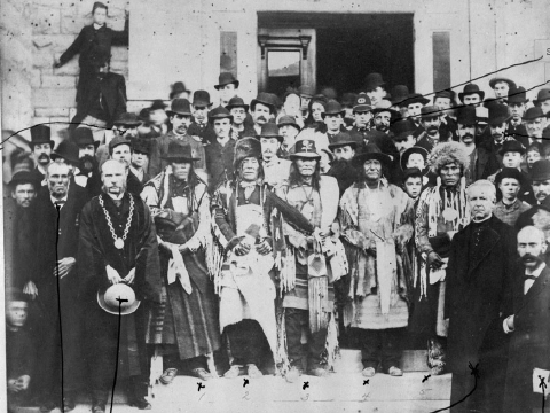
Presentation of an address to Chief Crowfoot and other Indian Chiefs by the City of Ottawa. Front row: (left to right) - W.P. Lett; His Worship Mayor McDougal; One Spot, sub-chief of the Bloods; Three Bulls, half-brother of Crowfoot; Chief Crowfoot; Red Cloud, Chief of the Bloods, North Axe, Chief of the Piegans; Rev. Father Lacombe, Ald. F.R.E. Campeau. LAC, PA-066624, 1886
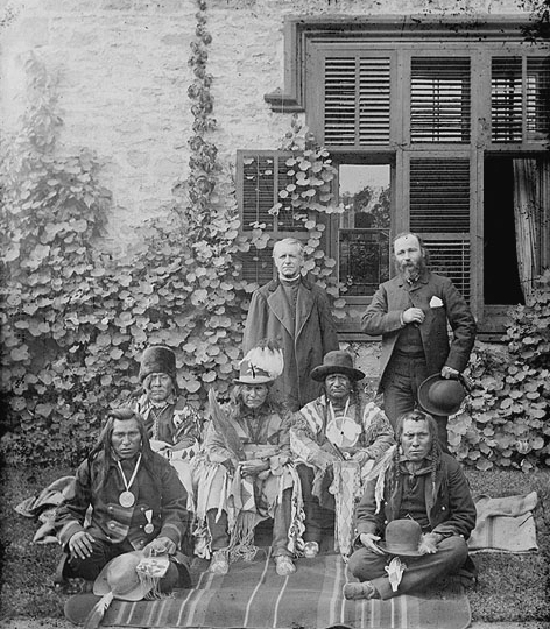
Blackfeet at Earnscliffe, "Front row", left to right: North Axe, Peigan Chief, One Spot, Blood sub-chief. "Middle row", left to right: Three Bulls, half brother of Crowfoot, Crowfoot, Blackfoot Chief, Red Cloud, Blood Chief. "Back row", left to right: Father Lacombe, John L'Heureux, interpreter, LAC, PA-045666, 1886

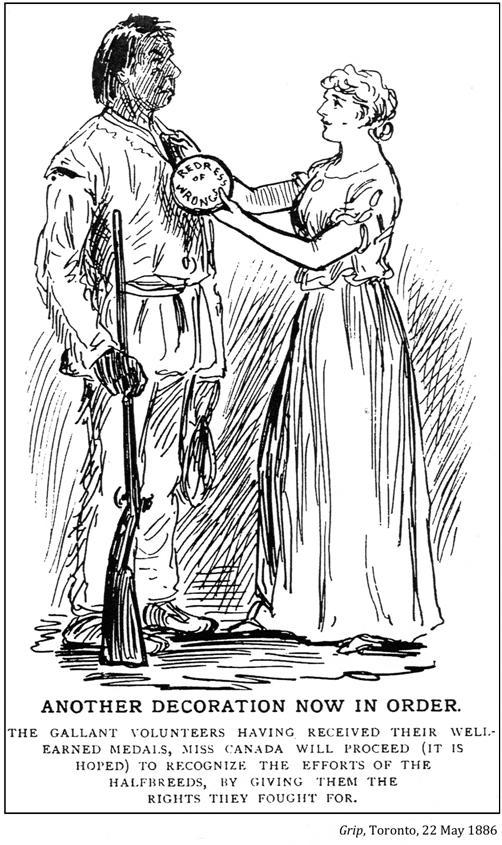

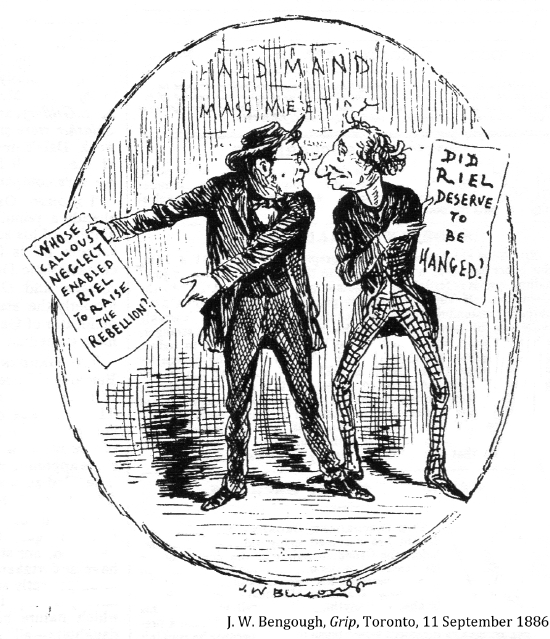


The Battalion of Hangmen: Remember the Traitors! 1887, LAC C-54882


Jean-Louis and Angelique Riel, children of Louis Riel. Les enfants de Louis Riel, Jean-Louis et Angélique Riel. Steele & Wing, LAC PA-139072, 1888-89

Small sized lapel button showing a portrait of Sir Wilfrid Laurier, 1896. Library and Archives Canada, Acc. No. R1300-1012


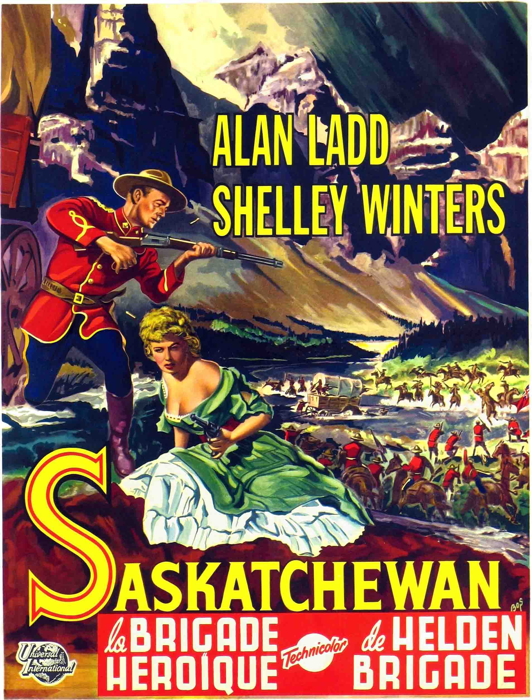

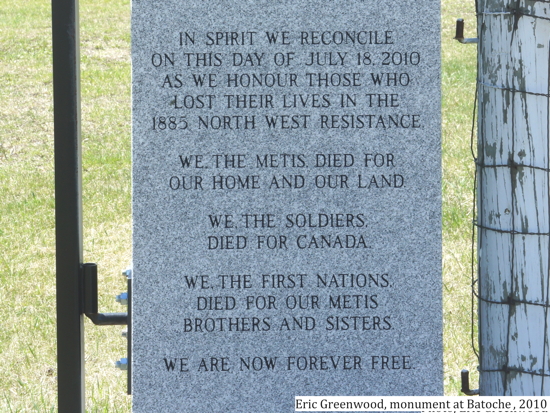



John Nugent, Saskatchewan Legislative grounds, 1968-1991
"The artist .. . chose to present the memory of Riel as an incredibly strong, intense and spiritual person who was reaching to grasp the future for his people."
Rand E. Teed, The Leader Post, Regina, 16 August 1991
"The statue depicts Riel clad in a simple, but revealing, cloak, his head and right hand thrust heavenward in a final set of defiance before his people's surrender to the troops of General Middleton at Batoche."
David Roberts, The Globe and Mail, Toronto, 8 August 1991
"We [the Metis] find it offensive because of the way Louis Riel is depicted. He's a grotesque man with no pants on and his testacles are hanging down. Can you imagine the controversy if John Diefenbaker was portrayed with no pants – or John A. Macdonald."
Jim Durocher, president of the Metis Society of Saskatchewan, The Globe and Mail , 8 August 1991
"The statue [of Riel] is graceful and portraying an idealist with dignity."
Muriel K. Griffin, The Leader Post, Regina, 9 September 1991
"I thought if I put anything else on him [other than a robe] I would date the man. I became very interested in Riel not just as an historical figure, but as a contemporary man with as much importance for the future as the past."
John Nugent, sculptor, The Leader Post, Regina, 2 October 1968
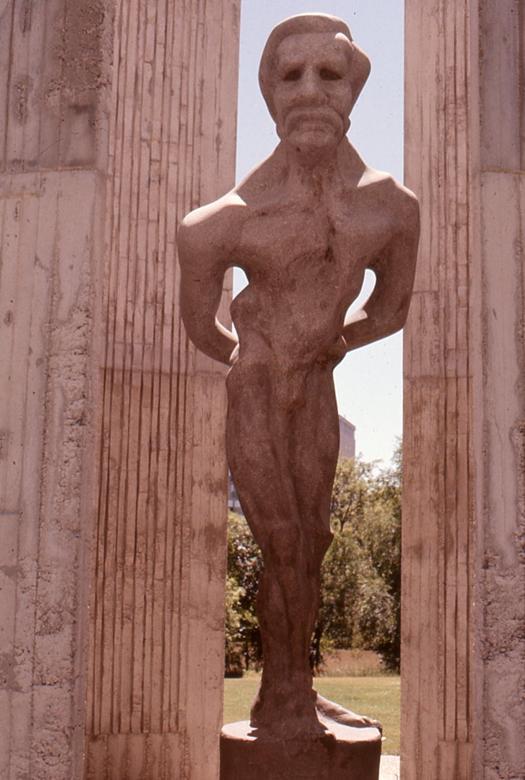
Marcien Lemay and Étienne Gaboury, Legislative Assembly of Manitoba grounds, 1971-1995
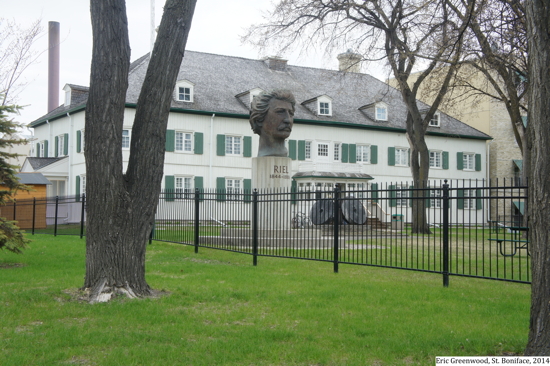
Réal Bernard, St. Boniface Museum, late 1980s
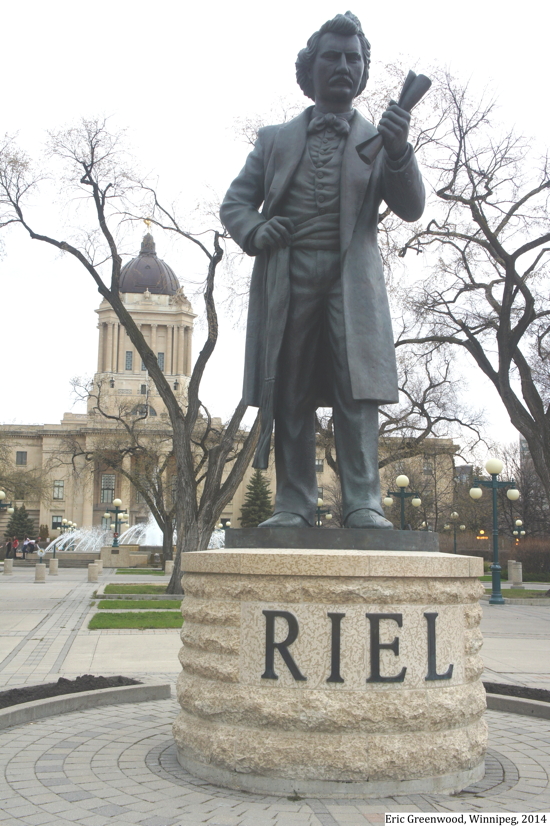
Miguel Joyal, Manitoba Legislative Buildings, 1995

The Invitation' is the latest sculpture along Highway 11 dedicated to Métis history in Saskatchewan. (Don Wilkins, 2015)
"We know all about Gettysburg and nothing about Batoche, which was the turning point in Canadian history."
Rudy Wiebe, 1978

Everett Soop Akwasasne Notes June 1970
"A large force was being sent to crush a few people who had been wronged and practically goaded into rebellion."
George T. Denison, 1900
"The frontier was melting away before the onslaught of steel."
Pierre Berton
"For years Macdonald's government had dragged its feet about coping with the grievances, but it was impressively prompt about crushing rebellion."
Desmond Morton, 1974
"As long as there is a Canada, its citizens will want to read about Louis Riel because his life summarizes in a unique way the tensions of being Canadian: English vs. French, native vs. white, East vs. West, Canadian vs. American."
Thomas Flanagan, 1985

https://teentalk.ca/2017/06/05/subjugation-of-truth-by-kent-monkman/
Our Canada 150 series continues with Subjugation of Truth by Kent Monkman. This painting shows Chief Pîhtokahanapiwiyin (Chief Poundmaker) and Chief Mistahi-maskwa (Chief Big Bear) sitting dejectedly before a table at which white men are signing away the chiefs’ freedom. Sir John A. Macdonald casts a dreamy look at a young Mountie, while a portrait on the wall shows Miss Chief (Monkman’s alter-ego) dressed as Queen Victoria.
Kent Monkman is a Two-Spirit artist of Cree ancestry who works with a variety of mediums, including painting, film/video, performance, and installation. His work often explores the colonialism of this land through a mix of mythical and overt imagery, humour and parody.
"The Métis Nation has never sought state clemency for Riel because, in their view, Riel doesn't need exoneration. Canada does."
Jean Teillet, A Worthy Excusing?, The Globe and Mail,14 November 2020

Mock trial of Louis Riel, photo by Mark Van Manen
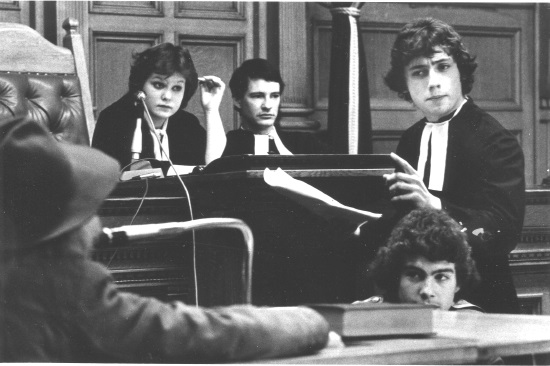
Mock trial of Louis Riel, photo by Mark Van Manen

Mock trial of Louis Riel, photo by Mark Van Manen
|












































































































































































